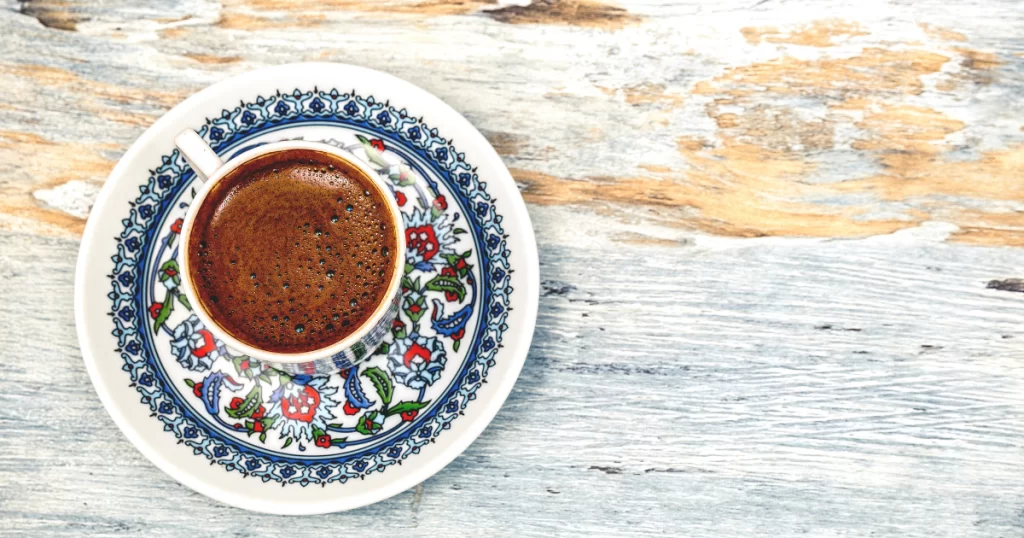Turkish coffee, for some the only drink that can turn them into night owls or keep them awake throughout a boring meeting.
Typically, it has between 40-60 milligrams of caffeine in a 3-ounce cup. This amount is higher than regular coffee but less than espresso.
However, you should keep in mind that we drink all these coffees in different ways and in different amounts.
Taking that into account, let’s explore the power of this history-rich coffee.
Want to understand the uniqueness of Turkish coffee? Don’t miss this article.
Why is Turkish coffee so strong?
The reason why Turkish coffee is so strong is the brewing process itself. Unlike drip or French press coffee, where the water passes through the grounds quickly, This type of coffee is brewed in a special pot called a cezve over low heat.
The water and grounds are heated slowly together until they come to a boil, meaning that all of the grounds remain in the cup when it’s poured.
For this reason, many people will think that this beverage has much more caffeine than it has. In reality, the taste itself is playing with your mind and senses.
Is Turkish coffee stronger than espresso?
Turkish coffee is traditionally brewed in a small cezve pot on low heat and consists of very finely ground beans.
This results in a strong and concentrated brew that packs a punch with every sip. On the other hand, espresso is made using high-pressure and hot water forced through finely ground beans.
The thick layer of foam that forms on top adds an extra depth to the overall taste experience that cannot be replicated by espresso. While some may argue that espresso reigns supreme in terms of strength and intensity, I personally find that unsweetened Turkish coffee has a much stronger taste.
Turkish coffee vs espresso caffeine – Side-by-side comparison
Turkish coffee isn’t stronger than espresso based on the caffeine per oz.
A standard shot of espresso has around 70mg of caffeine, while a traditional serving of Turkish coffee can range from 40 to 60 milligrams.
However, traditionally people drink more cups of coffee in one sitting, which can bump up their caffeine intake.

Is Turkish coffee stronger than regular coffee?
In my opinion, the answer is a resounding yes. And the reason is in the brewing process.
The beans are ground into an extremely fine powder and then boiled in water without any filtering.
Regular coffee, on the other hand, is typically brewed with a filter or press, which removes some of these elements.
You are probably drinking a cup of regular coffee that contains around 8 ounces of liquid. However, with Turkish coffee, servings are much smaller – typically just two or three ounces per cup.
Turkish coffee caffeine vs regular coffee – Side-by-side comparison
Turkish coffee has more caffeine than regular coffee if we compare based on ounces. Regular coffee has 12-18 mg of caffeine per ounce, while Turkish coffee has around 25 mg of caffeine.
However, since most people drink 8 to 16 ounces of regular coffee, you will probably get more caffeine than from Turkish coffee.
If you are a newcomer to this Middle Eastern beverage, don’t miss this article, which explains why Turkish coffee taste different.
Conclusion
Turkish coffee is undoubtedly one of the strongest and most intense coffees in the world. With its unique brewing method, finely ground beans, and unfiltered texture, it packs a powerful punch with every sip.
While some may find its taste too strong or bitter for their liking, there’s no denying the energy boost and mental clarity it provides. But let’s not forget about its cultural significance.
This unique coffee has been a part of Turkish culture for centuries and is deeply rooted in tradition and hospitality. It’s more than just a simple cup of coffee; it’s a symbol of friendship, respect, and togetherness.
So next time you have the chance to try it, embrace the experience with open arms. Take a moment to appreciate its rich history and cultural value while savoring each sip.
My journey through renowned bars and coffee shops over five years, as a barista, coffee aficionado, and former bartender, has honed my pursuit for the perfect cup. My passion for coffee isn’t just about the brew—it’s about sharing the knowledge and insights I’ve gleaned along the way.



